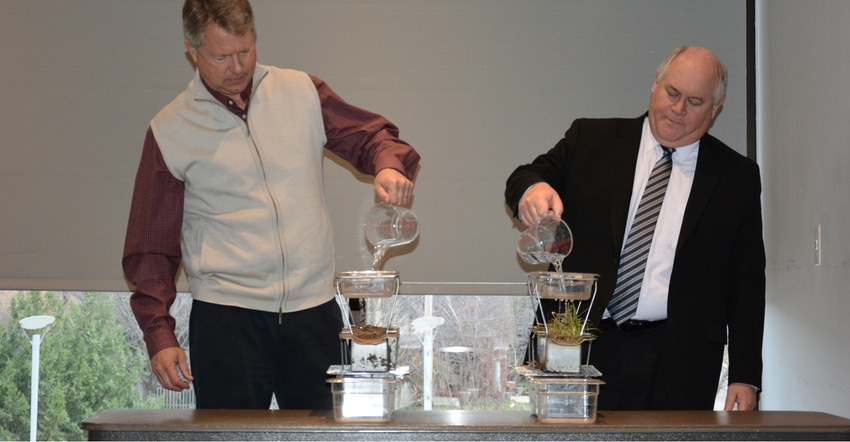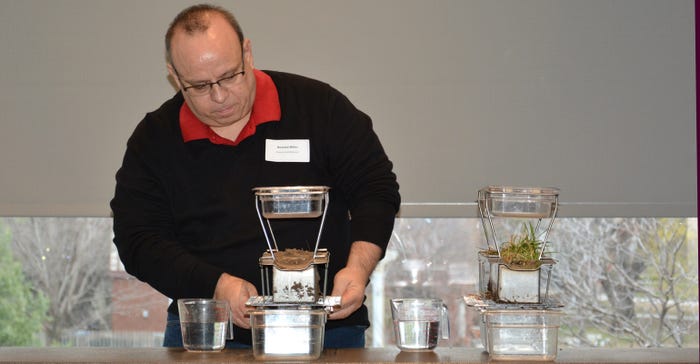
If there is any surprise to come from undertaking conservation efforts, it is what amazing success can be achieved from a small, determined, localized effort.
That is the story of the Cheney Watershed Project, an effort that is now more than 20 years old. The project is a federal-state-city-farmer partnership initiative that has resulted in delivering a 50-year-old major reservoir with a sedimentation rate of 5% and an expected lifespan of at least 200 more years.
That success has resulted from a dedicated partnership between the city of Wichita, Kan., and the farmers and ranchers in the North Fork of the Ninnescah watershed, aided in no small part by federal programs that continue to help farmers through conservation funding and cost share programs.
Cheney is the sixth largest reservoir in Kansas, with a surface area of 9,550 acres. The lake covers 147 parcels of land that required the removal of 40 families during construction, which was completed in 1964.
One of those families was that of Marion Krehbiel, whose father gave up his family farm and actively campaigned to help assure that the displaced families got a fair price for their land and buildings. In the early 1990s, Marion and his friend, Lyle Newby, were among the farmers that were members of the Reno County Conservation Board, which was becoming increasingly concerned about silting-in of the reservoir.
Marion says he heard local fishermen talking about being able to walk further and further out in the lake as the sediment filled it in near the inlet from the river. For Marion, the issue was especially poignant. His historic family farm lies beneath the north end of the lake near the inlet.
He talked to Lyle, who suggested they talk to a Wichita engineer, Wilmer Freund, and get his ideas on what could be done to slow down the sedimentation.
Those talks resulted in the formation of the Citizens Management Committee in 1994, which worked as a subsidiary of the Conservation District with the explicit mission of telling fellow farmers and ranchers what kind of best management practices would be needed to reach the water quality goals they wanted to achieve for the reservoir.
 SETTING UP: Howard Miller, Outreach coordinator for the Cheney Watershed, sets up a rainfall runoff comparison demonstration during a meeting with Kansas Congressmen Roger Marshall and Ron Estes on the value of Farm Bill programs to preserving a watershed.
SETTING UP: Howard Miller, Outreach coordinator for the Cheney Watershed, sets up a rainfall runoff comparison demonstration during a meeting with Kansas Congressmen Roger Marshall and Ron Estes on the value of Farm Bill programs to preserving a watershed.

The city of Wichita agreed to provide some funding to help farmers implement those BMPs, and a dozen or more farmers volunteered to implement whatever practices the committee had decided would benefit the effort.
The committee has grown in the 24 years since it began, and is now coordinated by the Cheney Lake Watershed Inc. and led by Lisa French, who farms in the area with her husband, Jim, a senior advocacy advisor with the Center for Rural Affairs.
The management committee is comprised primarily of farmers and ranchers in the watershed, which extends over parts of Reno, Kingman, Stafford, Pratt and Kiowa counties before entering Sedgwick County at and below Cheney Lake.
More than 3,000 projects have been established to move livestock feeding areas away from streams, return land to grass or permanent vegetation, establish filter strips and riparian areas, enhance soil quality, and promote cover crop establishment to reduce the level of phosphorus flowing into the lake.
Notable federal programs supporting the Cheney Watershed effort are the Conservation Reserve Program and the working lands conservation programs, such as the Environmental Quality Incentives Program, the Conservation Stewardship Program and the Agricultural Conservation Easement Program. Wichita continues to provide funds to help farmers implement and maintain conservation practices that help preserve the lake, and the project has received some funds from the U.S. Environmental Protection Agency.
The Cheney Lake Watershed project has been voluntary and largely free from regulation at either the local or federal level, and leaders of the effort have reached out to their congressional representatives to help them understand how important farm bill programs have been in the success of their efforts.
Andy Ziegler, director of the Kansas Water Science Center, an agency of the U.S. Geological Survey, says that Cheney Watershed is a model for the nation on water quality. The lake is monitored with turbidity sensors in the streams that feed into it and algae sensors on boats that operate on the lake.
 NATIONAL MODEL: Andy Ziegler, director of the Kansas Water Science Center, an agency of the U.S. Geological Survey, said that Cheney Watershed is a model for the nation on water quality.
NATIONAL MODEL: Andy Ziegler, director of the Kansas Water Science Center, an agency of the U.S. Geological Survey, said that Cheney Watershed is a model for the nation on water quality.

Cheney Watershed director Howard Miller pointed to studies that have shown again and again how much soil erosion is slowed by continuous vegetation, and how keeping the land covered improves water infiltration and prevents excessive loading of the lake with sediment during heavy rainfall events.
Preserving the watershed has involved enrolling about 20% of the land in CRP, converting CRP to permanent grazing land when contracts expired through use of EPA Section 319 funding, and utilizing the Watershed Restoration and Protection Strategy.
The Cheney Watershed members hold regular educational events and host a cover crop discussion group to encourage landowners to take advantage of programs that help them pay for implementing practices that preserve water quality and promote conservation.
About the Author(s)
You May Also Like




